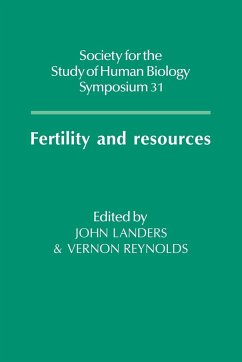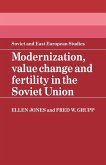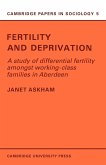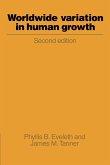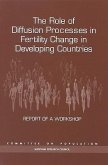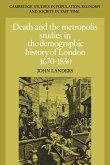Fertility and Resources
Herausgeber: Landers, John; Reynolds, Vernon
Fertility and Resources
Herausgeber: Landers, John; Reynolds, Vernon
- Broschiertes Buch
- Merkliste
- Auf die Merkliste
- Bewerten Bewerten
- Teilen
- Produkt teilen
- Produkterinnerung
- Produkterinnerung
In this book, the gap between socio-ecology and population demography is bridged, by showing how animals and humans adjust their fertility to environmental conditions.
Andere Kunden interessierten sich auch für
![Modernization, Value Change and Fertility in the Soviet Union Modernization, Value Change and Fertility in the Soviet Union]() Ellen JonesModernization, Value Change and Fertility in the Soviet Union54,99 €
Ellen JonesModernization, Value Change and Fertility in the Soviet Union54,99 €![Fertility and Deprivation Fertility and Deprivation]() Janet AskhamFertility and Deprivation29,99 €
Janet AskhamFertility and Deprivation29,99 €![Sociobiology and the Human Dimension Sociobiology and the Human Dimension]() Georg BreuerSociobiology and the Human Dimension48,99 €
Georg BreuerSociobiology and the Human Dimension48,99 €![Worldwide Variation in Human Growth Worldwide Variation in Human Growth]() Phyllis B. EvelethWorldwide Variation in Human Growth66,99 €
Phyllis B. EvelethWorldwide Variation in Human Growth66,99 €![The Role of Diffusion Processes in Fertility Change in Developing Countries The Role of Diffusion Processes in Fertility Change in Developing Countries]() National Research CouncilThe Role of Diffusion Processes in Fertility Change in Developing Countries24,99 €
National Research CouncilThe Role of Diffusion Processes in Fertility Change in Developing Countries24,99 €![Population and Global Security Population and Global Security]() Nicholas Polunin (ed.)Population and Global Security111,99 €
Nicholas Polunin (ed.)Population and Global Security111,99 €![Death and the Metropolis Death and the Metropolis]() John LandersDeath and the Metropolis47,99 €
John LandersDeath and the Metropolis47,99 €-
-
-
In this book, the gap between socio-ecology and population demography is bridged, by showing how animals and humans adjust their fertility to environmental conditions.
Hinweis: Dieser Artikel kann nur an eine deutsche Lieferadresse ausgeliefert werden.
Hinweis: Dieser Artikel kann nur an eine deutsche Lieferadresse ausgeliefert werden.
Produktdetails
- Produktdetails
- Verlag: Cambridge University Press
- Seitenzahl: 208
- Erscheinungstermin: 31. Oktober 2008
- Englisch
- Abmessung: 229mm x 152mm x 12mm
- Gewicht: 346g
- ISBN-13: 9780521103039
- ISBN-10: 0521103037
- Artikelnr.: 25856316
- Herstellerkennzeichnung
- Libri GmbH
- Europaallee 1
- 36244 Bad Hersfeld
- gpsr@libri.de
- Verlag: Cambridge University Press
- Seitenzahl: 208
- Erscheinungstermin: 31. Oktober 2008
- Englisch
- Abmessung: 229mm x 152mm x 12mm
- Gewicht: 346g
- ISBN-13: 9780521103039
- ISBN-10: 0521103037
- Artikelnr.: 25856316
- Herstellerkennzeichnung
- Libri GmbH
- Europaallee 1
- 36244 Bad Hersfeld
- gpsr@libri.de
List of contributors; 1. Introduction J. Landers and V. Reynolds; 2.
Environmental and social determinants of fecundity in primates R. I. M.
Dunbar; 3. Biological aspects of fertility among Third World populations L.
Rosetta; 4. A preliminary report on fertility and socioeconomic changes in
two Papua New Guinea communities T. Taufa, V. Mea and J. Lourie; 5. The
cultural context of fertility transition in immigrant Mennonites J. C.
Stevenson and P. M. Everson; 6. Inter-relationships between consanguinity,
religion and fertility in Karnataka, South India A. H. Bittles, A. Radha
Rama Devi and N. Appaji Rao; 7. Resources and the fertility transition in
the countryside of England and Wales P. R. A. Hinde; 8. Fertility decline
and birth spacing among London Quakers J. Landers; 9. Population growth,
innovation and resource exploitation E. Boserup; 10. Fertility decline in
developing countries: the roles of economic modernisation, culture and
Government interventions J. Cleland; 11. Understanding recent fertility
trends in the Third World A. G. Hill; 12. Monogamy, landed property and
demographic regimes in pre-industrial Europe: regional contrasts and
temporal stabilities R. M. Smith; Index.
Environmental and social determinants of fecundity in primates R. I. M.
Dunbar; 3. Biological aspects of fertility among Third World populations L.
Rosetta; 4. A preliminary report on fertility and socioeconomic changes in
two Papua New Guinea communities T. Taufa, V. Mea and J. Lourie; 5. The
cultural context of fertility transition in immigrant Mennonites J. C.
Stevenson and P. M. Everson; 6. Inter-relationships between consanguinity,
religion and fertility in Karnataka, South India A. H. Bittles, A. Radha
Rama Devi and N. Appaji Rao; 7. Resources and the fertility transition in
the countryside of England and Wales P. R. A. Hinde; 8. Fertility decline
and birth spacing among London Quakers J. Landers; 9. Population growth,
innovation and resource exploitation E. Boserup; 10. Fertility decline in
developing countries: the roles of economic modernisation, culture and
Government interventions J. Cleland; 11. Understanding recent fertility
trends in the Third World A. G. Hill; 12. Monogamy, landed property and
demographic regimes in pre-industrial Europe: regional contrasts and
temporal stabilities R. M. Smith; Index.
List of contributors; 1. Introduction J. Landers and V. Reynolds; 2.
Environmental and social determinants of fecundity in primates R. I. M.
Dunbar; 3. Biological aspects of fertility among Third World populations L.
Rosetta; 4. A preliminary report on fertility and socioeconomic changes in
two Papua New Guinea communities T. Taufa, V. Mea and J. Lourie; 5. The
cultural context of fertility transition in immigrant Mennonites J. C.
Stevenson and P. M. Everson; 6. Inter-relationships between consanguinity,
religion and fertility in Karnataka, South India A. H. Bittles, A. Radha
Rama Devi and N. Appaji Rao; 7. Resources and the fertility transition in
the countryside of England and Wales P. R. A. Hinde; 8. Fertility decline
and birth spacing among London Quakers J. Landers; 9. Population growth,
innovation and resource exploitation E. Boserup; 10. Fertility decline in
developing countries: the roles of economic modernisation, culture and
Government interventions J. Cleland; 11. Understanding recent fertility
trends in the Third World A. G. Hill; 12. Monogamy, landed property and
demographic regimes in pre-industrial Europe: regional contrasts and
temporal stabilities R. M. Smith; Index.
Environmental and social determinants of fecundity in primates R. I. M.
Dunbar; 3. Biological aspects of fertility among Third World populations L.
Rosetta; 4. A preliminary report on fertility and socioeconomic changes in
two Papua New Guinea communities T. Taufa, V. Mea and J. Lourie; 5. The
cultural context of fertility transition in immigrant Mennonites J. C.
Stevenson and P. M. Everson; 6. Inter-relationships between consanguinity,
religion and fertility in Karnataka, South India A. H. Bittles, A. Radha
Rama Devi and N. Appaji Rao; 7. Resources and the fertility transition in
the countryside of England and Wales P. R. A. Hinde; 8. Fertility decline
and birth spacing among London Quakers J. Landers; 9. Population growth,
innovation and resource exploitation E. Boserup; 10. Fertility decline in
developing countries: the roles of economic modernisation, culture and
Government interventions J. Cleland; 11. Understanding recent fertility
trends in the Third World A. G. Hill; 12. Monogamy, landed property and
demographic regimes in pre-industrial Europe: regional contrasts and
temporal stabilities R. M. Smith; Index.

